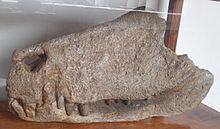Barinasuchus
|
Barinasuchus Temporal range: Middle Eocene - Middle Miocene |
|
|---|---|
 |
|
| Holotype fossil of Barinasuchus arveloi | |
| Scientific classification | |
| Kingdom: | Animalia |
| Phylum: | Chordata |
| Class: | Reptilia |
| Branch: | †Sebecosuchia |
| Clade: | †Sebecia |
| Family: | †Sebecidae |
| Genus: |
†Barinasuchus Paolillo and Linares, 2007 |
| Type species | |
|
†B. arveloi Paolillo and Linares, 2007 |
|
Barinasuchus (meaning "Barinas crocodile," in reference to where the type material was found) is an extinct genus of sebecid mesoeucrocodylian. Its fossils have been found in middle Eocene-age rocks of the Divisadero Largo Formation of Argentina, middle Miocene-age rocks of the Ipururo Formation of Peru, and middle Miocene-age rocks of the Parángula Formation of Venezuela.
The holotype comes from Parángula Formation rocks in Barinas and consists of an incomplete articulated skull and lower jaw. Like all other sebecosuchians, it was a terrestrial carnivore with ziphodont teeth, like a theropod dinosaur. This made it a formidable predator.
Barinasuchus is the largest sebecosuchian (preserved part of the type specimen skull is 700 millimetres (28 in) long), and is the first sebecosuchian known from Venezuela. Fossils from Peru previously identified as Sebecus cf. huilensis have been assigned to the type species, B. arveloi.
Barinasuchus was described in 2007 by Alfredo Paolillo and Omar Linares.
...
Wikipedia
